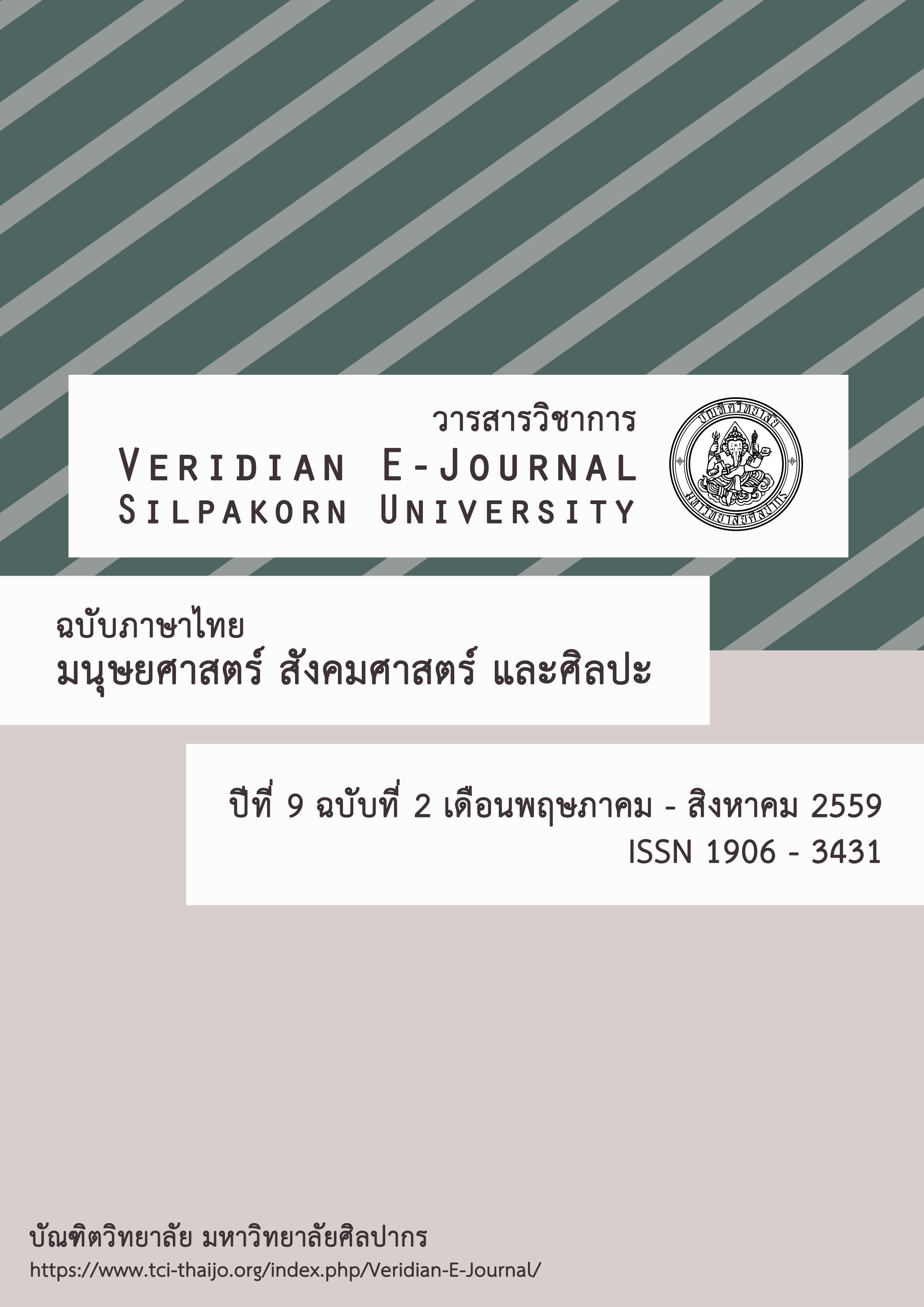การพัฒนารูปแบบผลิตภัณฑ์ผ้าทอไทยทรงดำเพื่อสร้างมูลค่าเพิ่มตามแนวทาง เศรษฐกิจสร้างสรรค์
Main Article Content
Abstract
การวิจัยเรื่อง การพัฒนารูปแบบผลิตภัณฑ์ผ้าทอไทยทรงดำเพื่อสร้างมูลค่าเพิ่มตามแนวทางเศรษฐกิจสร้างสรรค์เป็นการวิจัยและพัฒนา (Research and Development) มีวัตถุประสงค์เพื่อ 1) ศึกษาการสร้างเอกลักษณ์และการสื่อความหมายของลวดลายผ้าไทยทรงดำในอำเภอบางเลนและอำเภอกำแพงแสน จังหวัดนครปฐม 2) ศึกษาและสังเคราะห์แนวคิดการสร้างมูลค่าเพิ่มของผลิตภัณฑ์ผ้าทอไทยทรงดำ 3) พัฒนารูปแบบผลิตภัณฑ์จากผ้าทอไทยทรงดำตามแนวคิดเศรษฐกิจสร้างสรรค์ และ 4) ทดสอบแนวคิดผลิตภัณฑ์จากผ้าทอไทยทรงดำที่ได้พัฒนาขึ้น ประชากรและกลุ่มตัวอย่างที่ใช้ในการวิจัยคือ (1) กลุ่มชาวไทยทรงดำในตำบลไผ่หูช้าง อำเภอบางเลน และตำบลดอนข่อย อำเภอกำแพงแสน จังหวัดนครปฐม (2) กลุ่มลูกค้าเป้าหมายในการศึกษาความต้องการชนิดของผลิตภัณฑ์ผ้าทอไทยทรงดำ จำนวน 150 คน (3) กลุ่มลูกค้าเป้าหมายในการทดสอบผลิตภัณฑ์ใหม่ (Product Testing) จำนวน 100 คน และ (4) ผู้เชี่ยวชาญด้านการออกแบบผลิตภัณฑ์ผ้าทอ จำนวน 3 คน เครื่องมือที่ใช้ในการวิจัยคือ แบบสัมภาษณ์เชิงลึกแบบมีโครงสร้าง (Structured Interview) และแบบสอบถาม และวิเคราะห์ข้อมูลด้วยสถิติบรรยาย ได้แก่ ความถี่ ร้อยละ ค่าเฉลี่ย และส่วนเบี่ยงเบนมาตรฐาน ส่วนการวิเคราะห์ข้อมูลเชิงคุณภาพใช้การวิเคราะห์เนื้อหา (Content Analysis) ผลการวิจัยพบว่า
1. ผ้าทอและเครื่องแต่งกายของชาวไทยทรงดำถือเป็นเอกลักษณ์เฉพาะของกลุ่มชาติพันธุ์ไทยทรงดำ ที่มีเอกลักษณ์ในการใช้ผ้าสีดำในการนุ่งห่มทั้งในชีวิตประจำวันและในการประกอบพิธีกรรม จนเป็นเอกลักษณ์ที่โดดเด่นของชาวไทยทรงดำ โดยชาวไทยทรงดำนิยมใช้ผ้าพื้นสีดำทอขึ้นอย่างง่ายๆ มีสีสันและลวดลายบ้าง ซึ่งจากการศึกษาลวดลายผ้าไทยทรงดำพบว่าลวดลายต่างๆ สามารถแบ่งได้ 3 ประเภทคือ ลายพืช ลายสัตว์ และลายผสมอื่นๆ ในส่วนของการสื่อความหมายในการใช้สีในการทอผ้าและประดับตกแต่งของชาวไทยทรงดำ แต่ละสีมีความหมายแตกต่างกัน โดยเฉพาะสีครามเข้มหรือสีดำซึ่งเป็นสีหลักของผืนผ้าและการใช้งานของชาวไทยทรงดำ โดยสื่อความหมายว่าเกิดจากการเก็บกดที่ต้องพลัดพรากจากบ้านเกิดเมืองนอนมาเป็นชนกลุ่มน้อยในประเทศไทย
2. การศึกษาและสังเคราะห์แนวคิดการสร้างมูลค่าเพิ่มของผลิตภัณฑ์ผ้าทอไทยทรงดำ พบว่าในการออกแบบเกี่ยวกับผลิตภัณฑ์จากผ้าทอไทยทรงดำนั้น อันดับแรกผู้ออกแบบต้องคำนึงถึงหลักการออกแบบโดยทั่วไปที่สำคัญคือ ประโยชน์ใช้สอย อีกส่วนหนึ่งที่มีความสำคัญที่นักออกแบบจะต้องคำนึงถึงคือ การคงเอกลักษณ์และการสื่อความหมายของลวดลายและสีสันต่างๆ ตามความเชื่อของชาวไทยทรงดำ เนื่องจากลายผ้าไทยทรงดำมีลายต่างๆ ไม่มาก และมีการใช้สีสันที่จำกัด การออกแบบผลิตภัณฑ์จากผ้าทอไทยทรงดำจึงต้องมีความระมัดระวังเป็นพิเศษ โดยเฉพาะในเรื่องของการคงเอกลักษณ์ของชาวไทยทรงดำและความแตกต่างของวัฒนธรรมความเชื่อของแต่ละพื้นที่ๆ มีความแตกต่างกัน
3. คณะผู้วิจัยได้ดำเนินการพัฒนารูปแบบผลิตภัณฑ์จากผ้าทอไทยทรงดำ 4 ชนิดดังนี้ 1) หมอนอิง 2) กล่องกระดาษทิชชู 3) กระเป๋าสตรี และ 4) เสื้อผ้า ตามผลการศึกษาความต้องการผลิตภัณฑ์ผ้าทอไทยทรงดำของกลุ่มลูกค้าเป้าหมายใน 5 พื้นที่ ซึ่งพบว่ากลุ่มลูกค้าเป้าหมายมีความต้องการผลิตภัณฑ์จากผ้าทอไทยทรงดำสูงสุด 1 ลำดับแรกได้แก่ (1) หมอนอิง (2) กล่องกระดาษ ทิชชู (3) กระเป๋าสตรี (4) เสื้อ และ (5) กางเกง ในส่วนของระดับราคาของผลิตภัณฑ์ผ้าทอไทยทรงดำที่กลุ่มลูกค้าเป้าหมายต้องการมากที่สุดคือ 201 – 300 บาทต่อชิ้น
4. ผลการทดสอบแนวคิดผลิตภัณฑ์จากผ้าทอไทยทรงดำที่ได้พัฒนาขึ้นโดยศึกษาการรับรู้เอกลักษณ์และการรับรู้ความหมายของผู้บริโภคกลุ่มเป้าหมาย และการตรวจสอบแนวคิดผลิตภัณฑ์จากผ้าทอไทยทรงดำโดยผู้เชี่ยวชาญดังนี้ 1) หมอนอิง ได้แก่ แบบที่ 1 และแบบที่ 2 2) กล่องกระดาษทิชชู ได้แก่ แบบที่ 1 แบบที่ 3 และแบบที่ 4 3) กระเป๋าสตรี ได้แก่ แบบที่ 2 แบบที่ 3
This study was a research and development in aspect of research and development. The objectives of the study were to 1) study the identity initiation and signification of the Thai Song Dum style in Bang Len and Kamphaeng Saen Districts, Nakhon Pathom Province, 2) study and synthesize the concept of how to establish added value of Thai Song Dum woven fabric products, 3) develop product patterns from Thai Song Dum woven fabrics following the creative economy concept, and 4) examine the product concepts from Thai Song Dum woven fabrics developed. Population and samples in this study were 1) Thai Song Dum people in Phai Hu Chang Subdistrict, Bang Len District and Don Khoi Subdistrict, Kamphaeng Saen District, Nakhon Pathom, 2) 150 customers to investigate the need of Thai Song Dum product types, 3) 150 customers to study the new product test, and 4) 3 woven - product design experts. The research tools were structured interview and questionnaires. An analysis was performed by descriptive statistics, e.g., frequency, percentage, mean, and standard deviation. As for qualitative investigation, content analysis was carried out. The results revealed that;
1) Woven fabrics and apparels of Thai Song Dum people were the uniqueness of Thai Song Dum ethnic group; black fabrics have been used both in everyday activities and in rituals. It, eventually, was the identity of Thai Song Dum people. Garments of Thai Song Dum people were basically woven from black fabrics, together with few colors and decorations. Decorations on Thai Song Dum woven fabrics were categorized into 3 groups: plants, animals, and mixed styles. The implication of Thai Song Dum woven fabrics was performed by the coloration. Different colors conveyed different meanings; indigo or black signified the repression of migrating to be the minority in Thailand.
2) A study and synthesis of establishing added value of Thai Song Dum woven fabrics disclosed that the designers were required to consider the principles of design. First was function, especially psychological function. Second, identity maintenance and signification of decorations and colorations according to Thai Song Dum’s beliefs. Due to meager decorations and limited colors of Thai Song Dum style, product design must be cautious, especially in terms of the identity maintenance and the difference in cultures of different areas.
3) Form the customers’ point of view, the price of Thai Song Dum woven fabrics which customers were willing to pay was 201-300 THB per piece. The desire of Thai Song Dum woven fabrics of targeted customers from 5 areas revealed that top five of Thai Song Dum woven fabric products according to customers’ need were backrest pillows, napkin boxes, lady’s bags, shirts, and pants, respectively. Backrest pillows, napkin boxes, lady’s bags, and clothes, in the present study, were designed by the authors from outstanding weaving and sewing styles of Thai Song Dum people.
4) The product concepts testing of Thai Song Dum woven fabrics developed by the study of identity and meaning recognition of targeted customers, together with such examination from the experts led to the synopses of Thai Song Dum woven fabric patterns following economy concepts: the suitable design were type 1 and 2 for backrest pillows, type 1, 3, and 4 for napkin boxes and type 2 and type 3 for lady’s bags.

